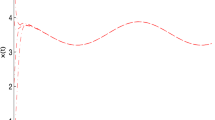Abstract
In this paper, we investigate the dynamics of the mathematical model of two non-interacting preys in presence of their common natural enemy (predator) based on the non-autonomous differential equations. We establish sufficient conditions for the permanence, extinction and global stability in the general non-autonomous case. In the periodic case, by means of the continuation theorem in coincidence degree theory, we establish a set of sufficient conditions for the existence of a positive periodic solutions with strictly positive components. Also, we give some sufficient conditions for the global asymptotic stability of the positive periodic solution.
Similar content being viewed by others
References
C. Azar, J. Holmberg and K. Lindgren,Stability analysis of harvesting in a predator-preymodel, J. Theort. Biol. 174 (1995), 13–19.
L. Barbalat,Systemes d' equations differentielles d'oscillations nonlineaires, Rev. Roumaine Math. Pures. Appl. 4 (1959), 267–270.
E. Beretta, Y. Kuang,Convergence results in a well-known predator prey system, J. Math. Anal. Appl. 204 (1996) 840–853.
D. K. Bhattachaya and S. Karan,Pest managment of two non-interacting pests in presence of common predator, J. Appl. Math. Computing 13 (2003), 301–322.
M. Cavani and M. Lizana,Stable perriodic for a predator-prey model with delay, J. Math. Anal. Appl. 249 (2000), 324–339.
M. Feng and K. Wang,Global existence of positive periodic solutions of periodic-predator-prey system with infinite delays, J. Math. Anal. Appl. 262 (2001), 1–11.
R. E. Gaines and J. L. Mawhin,Coincidence degree and nonlinear differential equations, Springer, Berlin, 1977.
K. Gopalsamy,Stability and oscillations in delay differential equations of population dynamics, Kluwer Academic, Dordrecht, The Netherlands, 1992.
X.-Z. He,Stability and delays in a predator prey system, J. Math. Anal. Appl.198 (1996) 355–370.
W. Krawcewicz and J. Wu,Theory of degrees with applications to bifurcations and differential equations, John Wily, New York, 1997.
Y. Kuang,Delay differential equations with applications in population dynamics, Academic press, New York, 1993.
S. Kumar, S. K. Sirvastava and P. Chingakham,Hopf bifurcation and stability analysis in a harvasted one-predator-two-prey model, Appl. Math. Comp. 126 (2002), 107–118.
Y. Li,Positive periodic solution for neutral delay model, Acta Math. Scinica 39 (1996), 790–795.
Y. Li,Periodic solutions of a periodic neutral delay equations, J. Math. Anal. Appl. 214 (1997), 11–21.
Y. Li,Periodic solution of a periodic delay predator-prey system, Proc. Amer. Math. Soc. 127 (1999), 1331–1335.
S. H. Saker,Oscillation and global attractivity in a periodic delay hematopoiesis model, J. Appl. Math. and Computing 13(1–2) (2003), 287–300.
S. H. Saker,Oscillation and global attractivity of hematopoiesis model with delay time, Appl. Math. Comp. 136 (2003), no. 2–3, 27–36.
S. H. Saker and Sheba Agarwal,Oscillation and global attractivity in a nonlinear delay periodic model of respiratory dynamics, Comp. Math. Appl. 44 (2002), no. 5–6, 623–632.
S. H. Saker and S. Agarwal,Oscillation and global attractivity in a periodic Nicholson's Blowflies model, Mathl. Comp. Modelling 35 (2002), 719–731.
S. H. Saker and S. Agarwal,Oscillation and global attractivity of a periodic survival red blood cells model, Journal Dynamics of Continuous, Discrete and Impulsive Systems Series B: Applications & Algorithms, in press.
S. H. Saker and S. Agarwal,Oscillation and global attractivity in nonlinear delay periodic model of population dynamics, Applicable Analysis 81 (2002), 787–799.
Y. Takeuchi and N. Adachi,Existence and bifurcation of stable equilibrium in two-prey, one predator communities, Bull. Math. Biol. 45 (1983), 877–900.
S. Tang and L. Chen,Global qualitative analysis for a ratio-dependent predator-prey model with delay, J. Math. Anal. Appl. 266 (2002), 401–419.
W. Wang, G. Mulone, F. Salemi and V. Salone,Permanence, and stability of stage-structured predator-prey model, J. Math. Anal. Appl. 262 (2001), 499–528.
R. Xu and M. A. J. Chaplain,Persistence and global stability in a delayed Gause-type predator-prey system with dominating instantaneous negative feedbacks, J. Math. Anal. Appl. 256 (2002), 148–162.
R. K. Upadhyay, S. R. Iyengar and V. Rai,Stability and complexity in ecological systems, Chaos, Solitons and Fractals 11 (2000) 533–542.
Z. Zhang and Z. Wang,Periodic solutions for a two-species nonautonomous competition Lotka-Volterra pathch system with time delay, J. Math. Anal. Appl. 265 (2002), 38–48.
Author information
Authors and Affiliations
Corresponding author
Additional information
E. M. Elabbasy received his BS (1973) from Mansoura University and MSC (1977) from Ain Shams University Egypt. He got his Ph. D. (1980) from Wales, UK. His subject interest is oscillation theory of differential and difference equations and their applications and also the nonlinear dynamical systems. Now he is teaching in Department of Mathematics, Mansoura University.
S. H. Saker received his BSC (1993) and MSC (1997) from Mansoura university, Egypt and got his Ph. D. from Adam mickiewicz University, Poland (2002). His research interest focus on the oscillation theory of differential, difference equations and their applications and oscillation of dynamic equations on time scales which unify the oscillation of differential and difference equations. Now he is teaching in Department of Mathematics, Mansoura University.
Rights and permissions
About this article
Cite this article
Elabbasy, E.M., Saker, S.H. Dynamics of a class of non-autonomous systems of two non-interacting preys with common predator. JAMC 17, 195–215 (2005). https://doi.org/10.1007/BF02936049
Received:
Revised:
Issue Date:
DOI: https://doi.org/10.1007/BF02936049



